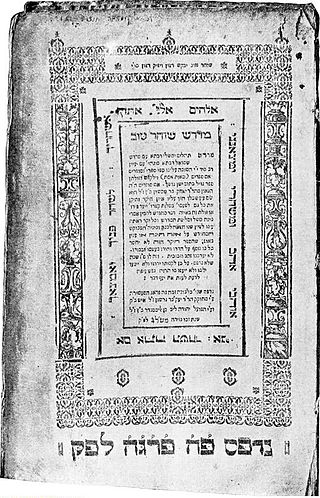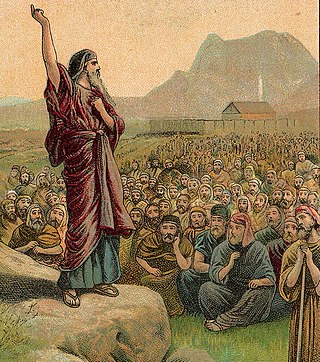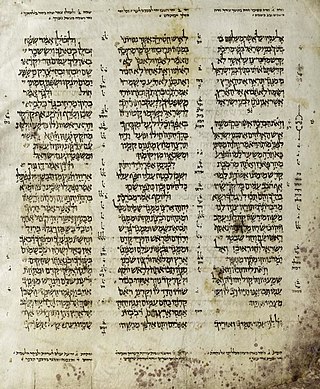Related Research Articles
Halakha, also transliterated as halacha, halakhah, and halocho, is the collective body of Jewish religious laws that are derived from the Written and Oral Torah. Halakha is based on biblical commandments (mitzvot), subsequent Talmudic and rabbinic laws, and the customs and traditions which were compiled in the many books such as the Shulchan Aruch. Halakha is often translated as "Jewish law", although a more literal translation might be "the way to behave" or "the way of walking". The word is derived from the root which means "to behave". Halakha not only guides religious practices and beliefs; it also guides numerous aspects of day-to-day life.

Judah ha-Nasi or Judah I, known simply as Rebbi or Rabbi, was a second-century rabbi and chief redactor and editor of the Mishnah. He lived from approximately 135 to 217 CE. He was a key leader of the Jewish community in Roman-occupied Judea after the Bar Kokhba revolt.

Midrash is expansive Jewish Biblical exegesis using a rabbinic mode of interpretation prominent in the Talmud. The word itself means "textual interpretation", "study", or "exegesis", derived from the root verb darash (דָּרַשׁ), which means "resort to, seek, seek with care, enquire, require".

Rabbinic literature, in its broadest sense, is the entire spectrum of works authored by rabbis throughout Jewish history. The term typically refers to literature from the Talmudic era, as opposed to medieval and modern rabbinic writings. It aligns with the Hebrew term Sifrut Chazal, which translates to “literature [of our] sages” and generally pertains only to the sages (Chazal) from the Talmudic period. This more specific sense of "Rabbinic literature"—referring to the Talmud, Midrashim, and related writings, but hardly ever to later texts—is how the term is generally intended when used in contemporary academic writing. The terms mefareshim and parshanim almost always refer to later, post-Talmudic writers of rabbinic glosses on Biblical and Talmudic texts.

Torah study is the study of the Torah, Hebrew Bible, Talmud, responsa, rabbinic literature, and similar works, all of which are Judaism's religious texts. According to Rabbinic Judaism, the study is done for the purpose of the mitzvah ("commandment") of Torah study itself.
According to Jewish tradition, the Torah contains 613 commandments. This myth is first recorded in the 3rd century CE, when Rabbi Simlai mentioned it in a sermon that is recorded in Talmud Makkot 23b. Other classical sages who hold this view include Rabbi Simeon ben Azzai and Rabbi Eleazar ben Yose the Galilean. It is quoted in Midrash Exodus Rabbah 33:7, Numbers Rabbah 13:15–16; 18:21 and Talmud Yevamot 47b. The 613 commandments include "positive commandments", to perform an act, and "negative commandments", to abstain from an act. The negative commandments number 365, which coincides with the number of days in the solar year, and the positive commandments number 248, a number ascribed to the number of bones and main organs in the human body.
In its primary meaning, the Hebrew word mitzvah refers to a commandment from God to be performed as a religious duty. Jewish law in large part consists of discussion of these commandments. According to religious tradition, there are 613 such commandments.
According to Rabbinic Judaism, the Oral Torah or Oral Law are statutes and legal interpretations that were not recorded in the Five Books of Moses, the Written Torah, and which are regarded by Orthodox Jews as prescriptive and given at the same time. This holistic Jewish code of conduct encompasses a wide swathe of rituals, worship practices, God–man and interpersonal relationships, from dietary laws to Sabbath and festival observance to marital relations, agricultural practices, and civil claims and damages.

Rabbinic Judaism, also called Rabbinism, Rabbinicism, or Rabbanite Judaism, has been an orthodox form of Judaism since the 6th century CE, after the codification of the Babylonian Talmud. Rabbinic Judaism has its roots in the Pharisaic school of Second Temple Judaism, and is based on the belief that Moses at Mount Sinai received both the Written Torah and the Oral Torah from God. The Oral Torah, transmitted orally, explains the Written Torah. At first, it was forbidden to write down the Oral Torah, but after the destruction of the Second Temple, it was decided to write it down in the form of the Talmud and other rabbinic texts for the sake of preservation.

Aggadah is the non-legalistic exegesis which appears in the classical rabbinic literature of Judaism, particularly the Talmud and Midrash. In general, Aggadah is a compendium of rabbinic texts that incorporates folklore, historical anecdotes, moral exhortations, and practical advice in various spheres, from business to medicine.

Shlach, Shelach, Sh'lah, Shlach Lecha, or Sh'lah L'kha is the 37th weekly Torah portion in the annual Jewish cycle of Torah reading and the fourth in the Book of Numbers. Its name comes from the first distinctive words in the parashah, in Numbers 13:2. Shelach is the sixth and lecha is the seventh word in the parashah. The parashah tells the story of the twelve spies sent to assess the promised land, commandments about offerings, the story of the Sabbath violator, and the commandment of the fringes.

Va'etchann is the 45th weekly Torah portion in the annual Jewish cycle of Torah reading and the second in the Book of Deuteronomy. It comprises Deuteronomy 3:23–7:11. The parashah tells how Moses asked to see the Land of Israel, made arguments to obey the law, recounted setting up the Cities of Refuge, recited the Ten Commandments and the Shema, and gave instructions for the Israelites' conquest of the Land. The parashah is made up of 7,343 Hebrew letters, 1,878 Hebrew words, 122 verses, and 249 lines in a Torah Scroll. Jews in the Diaspora generally read it in late July or August.

Berakhot is the first tractate of Seder Zeraim of the Mishnah and of the Talmud. The tractate discusses the rules of prayers, particularly the Shema and the Amidah, and blessings for various circumstances.

Eikev, Ekev, Ekeb, Aikev, or ʿEqeb is the 46th weekly Torah portion in the annual Jewish cycle of Torah reading and the third in the Book of Deuteronomy. It comprises Deuteronomy 7:12–11:25. The parashah tells of the blessings of obedience to God, the dangers of forgetting God, and directions for taking the Land of Israel. Moses recalls the making and re-making of the Tablets of Stone, the incident of the Golden Calf, Aaron's death, the Levites' duties, and exhortations to serve God.

Nitzavim, Nitsavim, Nitzabim, Netzavim, Nisavim, or Nesabim is the 51st weekly Torah portion in the annual Jewish cycle of Torah reading and the eighth in the Book of Deuteronomy. It comprises Deuteronomy 29:9–30:20. In the parashah, Moses told the Israelites that all the people stood before God to enter into the covenant, violation of which would bring on curses, but if they returned to God and heeded God's commandments, then God would take them back in love and bring them together again from the ends of the world. Moses taught that this Instruction was not beyond reach, and Moses put before the Israelites life and death, blessing and curse, and exhorted them to choose life by loving God and heeding the commandments.

V'Zot HaBerachah, VeZos HaBerachah, VeZot Haberakha, V'Zeis Habrocho, V'Zaus Haberocho, V'Zois Haberuchu, Wazoth Habborocho, or Zos Habrocho is the 54th and final weekly Torah portion in the annual Jewish cycle of Torah reading and the 11th and last in the Book of Deuteronomy. It constitutes Deuteronomy 33:1–34:12. The parashah sets out the farewell Blessing of Moses for the 12 Tribes of Israel and concludes with the death of Moses.
The following outline is provided as an overview of and topical guide to Judaism:
The prohibition against slaughtering an animal and its offspring on the same day is a negative commandment in Judaism which forbids the slaughter of a kosher four-legged animal and its offspring on the same day.

Jewish law and custom prescribe ritual hand washing in a number of situations. This practice is generally known by the Hebrew term נטילת ידיים, which literally means taking up of the hands.
References
- ↑ Elon Jewish Law 14:3, 14:5
Sources
- On the baraita of Hillel the Elder, see Tosefta Berakhot 6:24 and Lieberman ad loc.
- Talmud Berakhot 63
- Nathan Birnbaum, “Et la’asot,” //trans: "It is time to work (for the Lord)" // in Nathan Birnbaum, ed., Divrei ha-olim (Vienna, 1917)
- Elon. Jewish law
- Jacobs. A Tree of Life: Diversity, Flexibility, and Creativity in Jewish Law
- Urbach. The Sages
Other uses:
- Ra'avad on Maimonides (H. Mamrim 2:9)
- Jacob Emden's responsum on concubinage also relies on the verse.
- Franz Rosenzweig uses the verse in his public letter to Hermann Cohen, It is Time: Thoughts on the Problem of Jewish Education at this Moment (Berlin, 1917) //Zeit ists (German) Et la'asot (Hebrew)
Other uses:
- In an aggadic midrash, the cock sings the verse as a call to work. Ginsburg, Legends of the Jews, I:3
- There is an Israeli periodical named after this verse, Et la'asot //trans: "It is time to work (for the Lord)"